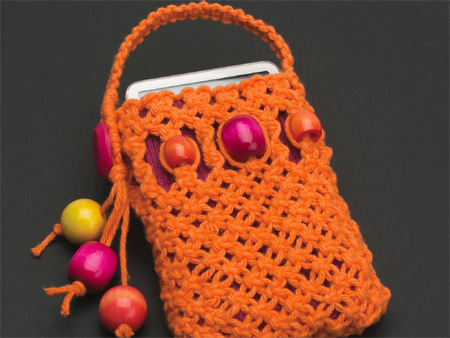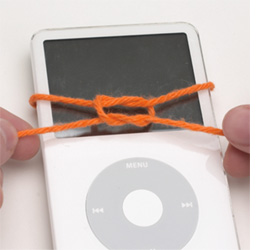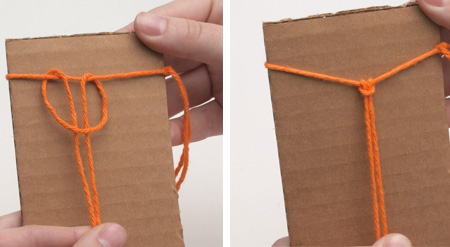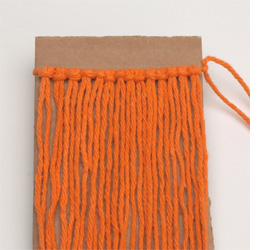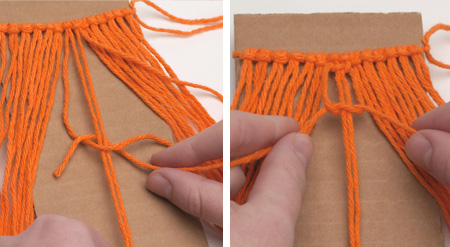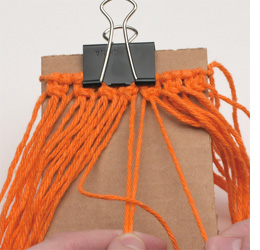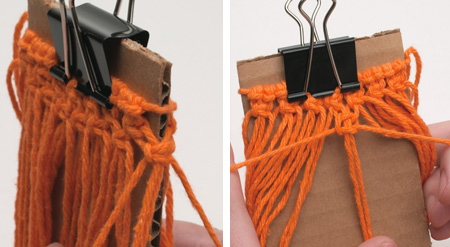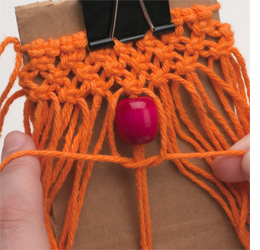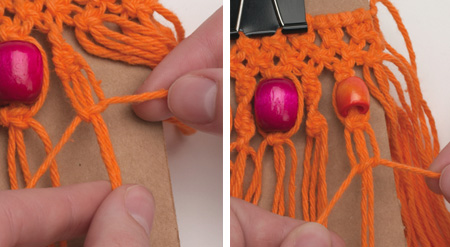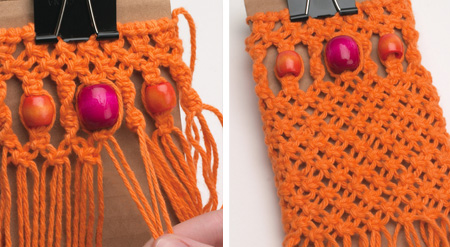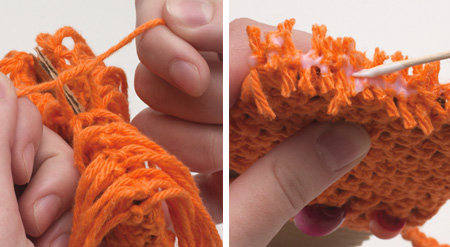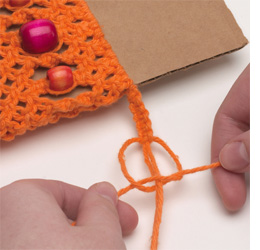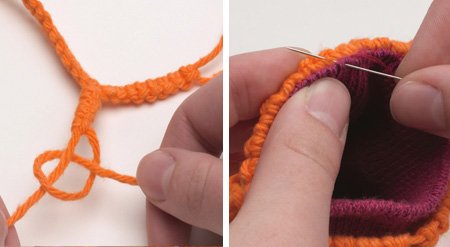Macramé iPod or cellphone holder
Once again becoming fashionable, macramé has come a long way since the 1970s when plant hangers were all the rage. Who would have dreamed I’d be using macramé knots to create a pouch for a high-tech device? It’s fun to knot accessories and jewellery using the new fibres and cords available. Here's how to make a storage pouch for an iPod or cellphone using coloured macramé cord.
YOU WILL NEED:
Thick, colourful wool or yarn
Wooden beads
Corrugated cardboard
Bulldop clip
Fabric glue.
Needle and thread
Button
Old sock, felt or fabric for lining
HERE'S HOW:
Cut 1 strand of yarn to a length of 100cm (1 metre) long for the holding cord, to which all of the cords will be tied. 2 Cut 28 strands of yarn, 150cm long. Cut 1 additional strand 150cm long and reserve for later.
To begin, wrap the holding cord (100cm piece) horizontally to fit around the iPod or cellphone, tying it in the centre with a square knot. This forms a loop that will serve as the holding cord to which you will tie the knotting cords. Make sure the ends of the cord are equal in length; they will be used later to form the strap.
Remove the loop from the iPod and place it around a piece of cardboard. You’ll use this piece of cardboard as a form to construct the pouch. (Cut the width of the cardboard so that the loop fits snugly around it, and cut the length a few centimetres longer than the iPod.) Pull the knot to one side and keep ends of the yarn up out of the way as you work.
Tie 28 strands to the holding cord, folding each in half and tying a lark’s head knot to secure. The image left shows how to begin the knot by placing the loop under the holding cord. Next, bring the ends of the cord through the loop and pull tight to complete the lark’s head knot.
Note: Knotting is all about tension. Keep your holding cord taut, which makes it easier to tie your working cord neatly around it.
Arrange 14 strands on each side of the cardboard. Starting with the 4 centre cords on one side of the cardboard, tie a square knot. Tie square knots on both sides with 4 cords each, until you have 7 knots tied. Tie the same 7 knots on the backside. This completes 1 row of knots all the way around the cardboard form. Add a bulldog clip to secure the holding cord to the top of the cardboard as you work.
For the second row, begin a row of alternating square knots. To tie alternating square knots, start with 2 knots next to each other. Take 2 cords from one knot and 2 from one beside it, and tie a new square knot between them using the 4 cords. Repeat across the row, tying square knots with all the remaining cords in the same manner. This row will leave you with 4 loose cords to tie a square knot on each edge of the cardboard (2 from the front, 2 from the back), to connect the knots all the way around the form.
Tie a 3rd row of alternating square knots all the way around the cardboard. Pick up the centre 2 cords and slide a large wooden bead over both cords, sliding the bead up to the finished knots. Tie 1 square knot under the bead. On each side of the centre bead, tie a sennit of half knots to form a spiral pattern, using 4 cords for each side. This knot is similar to the square knot, but you simply keep tying the same cord first on the same side, which forms a spiral pattern.
Tie the knots until each side equals the length of the centre bead and knot. With the 4 cords on each side of the spiral patterns, add a smaller bead to each side by tying 2 square knots above and below each bead, or enough knots to equal the length of the middle bead section.
Repeat the beaded patterns on the backside of the cardboard and fill in the sides of the work with sennits of spiral half-knot patterns formed from groups of 4 cords each.
Note: Use a pointed toothpick to aid in getting the ends of the cord through the bead if needed.
Finish the length with rows of alternating square knots; split the 4 cords under each bead into 2 cords on each side. Use these 2 cords paired with 2 cords from the spiral next to it to begin the alternating square knot pattern as shown.
Measure the length of the iPod or cellphone as you go. Stop tying knots when the work is slightly longer than the iPod.
Slip the work off the form, turn it inside out, and slide it back onto the cardboard. Form the bottom of the pouch by tying opposite strands from each side with square knots. Clip each cord about 1cm from the knot. Secure the knots by applying fabric glue. Let the knots dry. Turn the pouch right side out after the knots are dry. For a different look, instead of cutting and finishing the ends you can knot and leave them long for a funky beaded fringe.
Note: Fabric glue helps to secure the knots and keeps the ends of cords from fraying
Use the reserved 150cm" single strand of cord, fold it in half, and tie it over the loose ends of the holding cord with a lark’s head knot. Tie a sennit of square knots to make a strap. Finish by splitting the 4 strands into 2 pairs, with 2 on each side to form a buttonhole. Tie a sennit of lark’s head knots on each side. Measure to fit over the button. Finish by tying an overhand knot with all 4 strands.
Decorate the ends of the cords with beads, knotting under each to complete. Clip off the excess and finish the cord ends with fabric glue.
To prevent the cord or beads from scratching the screen, make a lining for the pouch. This will also give the pouch stability and structure. I used the top of a sock, cut to fit the pouch. Stitch the cut end of the sock closed and slip the sock inside the pouch. Stitch the top of the sock to the inside of the pouch around the top. Or cut a piece of felt, and stitch to fit inside the pouch. Sew a button to the side of the pouch for the strap.
oreilly media

